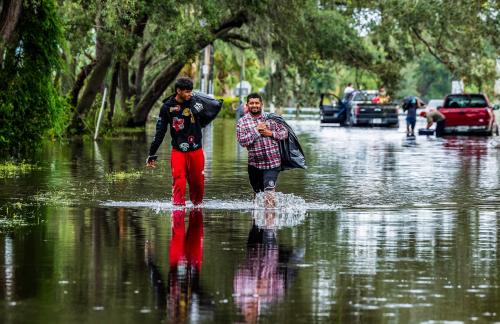On the surface, the history of U.S. environmental policy is one of sweeping success through pivotal regulation. The 1970 Clean Air Act, for example, is estimated to have reduced overall air pollution by 66.9% and added 1.3 years to the life expectancy of the average American.
But it is also a story of “one-size-fits-all” policy instead of equity and justice. Even as environmental legislation has reduced overall pollution, exposure to dangerous toxins has worsened for low-income households and, especially, people of color. Air pollution is between 10% and 15% above average in communities of color, and today more people of color live in “fence line communities” (neighborhoods near high-polluting facilities) than they did 30 years ago.
Last year’s Inflation Reduction Act (IRA) is another sweeping piece of environmental legislation—a $369 billion investment that is predicted to reduce emissions by up to 50% by 2050. However, for many in the climate and environmental justice community as well as a broader set of local planners and practitioners who have pushed to implement more equitable policies in their cities, the IRA falls short for its failure to legislate on justice.
That’s because the bill’s demand-driven approach—reliant on tax breaks and subsidies to incentivize climate change mitigation—means that climate resilience could actually become more inequitable and harm lower-income households and communities of color. But as this piece will explore, state and local leaders are well-positioned to strengthen measures for assessing and enforcing equity during the IRA’s implementation, potentially bending the law toward better outcomes for all communities.
How reparative is the IRA?
Earlier this year, we outlined a reparative stance for climate change policy—principles for environmental policy premised on closing racial wealth and prosperity gaps as a path to building climate resilience for households and communities. We focused on wealth, health, and financial and housing security, as these are the factors that amplify the individual costs—economic and personal—of climate change. These factors mediate climate risk, and they can make the difference between a disaster causing a temporary setback or entrenching poverty.
Fortunately, the Biden administration is taking progressive civil action seriously, especially in climate justice. President Biden signed the Community Disaster Resilience Zones Act into law, announced $177 million in funding for 17 technical assistance centers to help communities access environmental justice funds, and created the White House Office of Environmental Justice, which could be pivotal in designing new policy approaches that complement emissions reductions with inclusive climate resilience.
Alongside the Infrastructure Investment and Jobs Act (IIJA) as a central component of the administration’s policies driving climate action, it would be disingenuous to say that the IRA doesn’t include a commitment to justice and equity. It is supported by the Justice40 initiative, a policy to ensure that at least 40% of federal investments in climate policy flow to historically disadvantaged and overburdened communities. The IRA is also complemented by recent executive orders to reform governance structures, including plans to strengthen racial equity and support underserved communities across government agencies.
Moreover, the law includes at least $45.95 billion for environmental justice programs, including $10 billion in competitive grants. At about 12% of the IRA and 3.4% of the IRA and IIJA combined, these environmental justice commitments fall short of the Justice40 initiative (see Figure 1). Still, it’s no small change. These programs will be guided by the climate and economic justice screening tool, a Council on Environmental Quality-led mapping tool that helps federal agencies and local governments identify in-need communities based on vulnerability to climate risk.
While all of this is moving in the right direction, the IRA is still undergirded by a one-size-fits-all approach. We have written before about how the law doesn’t really reckon with equity, notably sidestepping codifying a process to score investments for equity outcomes. What exactly a successful environmental justice program will look like is unclear; the IRA’s lack of guidance for how successful program outcomes will be defined, measured, or sustained is a substantial gap that will make assessing and refining progress in equity challenging.
This is all to the detriment of the transformational potential of the IRA. The risk is this: Without a strategy that considers racial equity, climate change policies can become a vehicle that inadvertently widens racial wealth and prosperity gaps even while delivering emissions reductions. This has been the story of environmental policy in the U.S., and without action, it risks becoming the story of climate policy too.
The benefits of the IRA will not be distributed neutrally
The distribution of federal resources and their impacts on local pollution and climate vulnerability are more important than overall emissions reductions in terms of how communities of color are impacted by climate change. Because the legacies of racist policies have systemically concentrated vulnerability in specific places and communities, a distributionally neutral approach can cement underlying inequality. While it’s true that the IRA will drive decarbonization nationally and federal provisions for justice will help offset some unequal outcomes, inequity is still baked into the law’s key mechanisms.
First, demand-driven policies that don’t codify equity risk widen resilience divides by leaving low-income communities and communities of color behind. This is because the financial incentives in the bill are geared toward homeowners—typically middle- to high-income residents, the majority of whom are white. Moreover, others have pointed out the near complete lack of provisions for reducing the determinants of vulnerability, including housing security, equitable access to health care, and improving the provision of and access to public space. A more reparative policy would include provisions for renters and those in insecure employment and housing, thus addressing the underlying wealth gaps that leave these groups more vulnerable to climate change impacts and disasters.
Second, without restrictive supply-side regulation (meaning phasing out fossil fuel use), demand-side policies will prolong fossil fuel extraction, which will continue to overexpose communities of color to related harms. Oil companies made record profits in 2022, and following the Russian invasion of Ukraine, consumer prices sky-rocketed and companies expanded drilling projects in the United States. Already, big producers have doubled back on emissions reduction commitments. Relatedly, the IRA opens the door to carbon capture, utilization, and storage (CCUS) technology—an approach that coal and gas producers support, in part because it would allow for the continuation of fossil fuel burning. The most likely locations for this infrastructure are areas where communities are already overburdened by pollution from oil and gas refineries—for example, along the Gulf Coast, where large developments are already planned. This combination is bad news for many frontline communities that can’t afford to wait any longer for greater controls on local pollutants.
Some commentators, including our colleagues at Brookings, have argued that these compromises are worth it for accelerated climate action, on the basis that imperfect policies are better than none at all. But we argue that a failure to enact inclusive and equitable policy entails a wider social risk than just leaving some behind, as regressive policy can perpetuate a negative feedback loop that undermines the effectiveness of climate policy itself. The reason why international development agencies are increasingly supportive of inclusive climate action is not because they’re moral actors, but because it’s smart climate policy. The social costs of climate change—i.e., the impacts across the economy, from housing to health care—tend to be worse in countries that are less financially secure and more inequitable because of the way that these factors amplify climate risks (see Figure 2).
In the U.S., where race is frequently one of the largest predictors of climate vulnerability, it’s logical to pursue an approach to climate action premised on racial justice. But the IRA doesn’t answer some of the crucial questions we raised in our report on reparative climate policies. How will racial equity be codified into mitigation and adaptation policy? How will it guarantee progress in environmental justice during implementation? How will this policy reduce racialized gaps in climate resilience?
State and local implementation could bend the IRA toward more equitable outcomes
These limitations on climate justice mean that the IRA will need to be supported by local and state policies to have a better chance of achieving more equitable outcomes.
A good start for both levels of governance would be working with community partners in vulnerable regions to simplify access to the varying buckets of climate funds. Historically underinvested communities typically struggle to attract grant-based funding due to a lack of resources and expertise. Investing in community-based organizations through initiatives such as local equity navigators can help ensure that funds flow to where they’re needed the most. Emerging policies, such as the recently announced Community Disaster Resilience Zones, are an opportunity to co-develop resilience strategies with frontline communities and learn from the mistakes of past policies such as the Building Resilient Infrastructure and Communities program, which predominantly went to wealthy coastal communities.
Just as important will be how the IRA interacts with local policies that aren’t formally about climate but still affect it, such as those in housing, employment opportunities, community infrastructure, and the affordability of services that mediate climate vulnerability. Our colleagues have shown how the IRA’s interaction with other policies—including the IIJA and macroeconomic factors—will shape the law’s outcomes, but it will also determine its effectiveness at resolving racial disparities.
The extent to which local governments can plan for more equitable outcomes is likely to be mixed, with cities in some of the most vulnerable regions either less willing to act on climate justice or stymied by regressive state policies. Yet some regions are setting a positive example by spearheading complimentary racial justice initiatives that will amplify the IRA’s impacts on resilience. Task forces on reparations have been established in Boston, Rochester, N.Y., and San Francisco. Recently, Evanston, Ill. became the first city in the U.S. to grant residents direct reparations, and Los Angeles County has returned $20 million worth of land to the descendants of a Black family that had it stolen from them under eminent domain. Other cities, including New York and Chicago, are testing procedures to incorporate equity scoring into the planning processes for new infrastructure.
Similarly, some states are pursuing policies that will inadvertently or intentionally create better outcomes for communities of color. Good examples include tighter regulations on air pollution, like New York and New Jersey’s legislation to ban environmentally harmful developments in overburdened communities, and policies to improve affordable and sustainable housing for renters, such as Pennsylvania’s American Rescue Plan-funded Whole Home Repairs Program.
Though not intended as adaptation policy, these cases demonstrate an impetus for more reparative policy, not just a one-size-fits-all approach. The nascent White House Office of Environmental Justice should take note of this local and state momentum. A more just and equitable climate policy with measurable progress during implementation could provide structures that pair emissions reduction with programs to bolster adaptive capacity and reduce climate resilience gaps. In this, the IRA is lacking, but future policies don’t have to be.
The Brookings Institution is committed to quality, independence, and impact.
We are supported by a diverse array of funders. In line with our values and policies, each Brookings publication represents the sole views of its author(s).









Commentary
The US can’t achieve environmental justice through one-size-fits-all climate policy
June 1, 2023